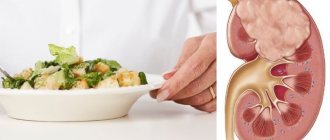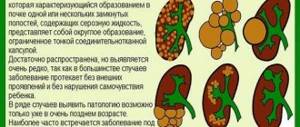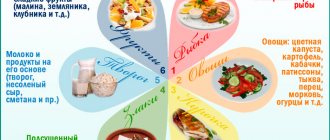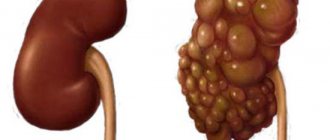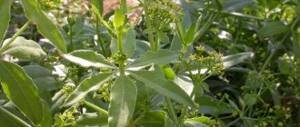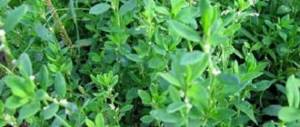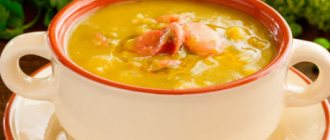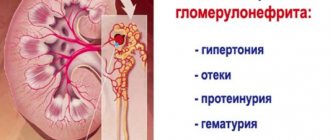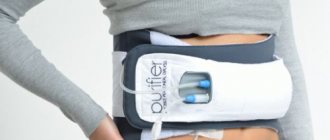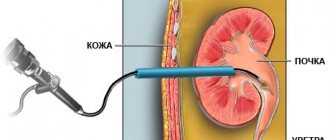Causes of oxalate in the kidneys
A deficiency of calcium in the body can cause the development of such manifestations of urolithiasis as the formation of oxalate stones in the kidneys; The main causes of the disease are a sedentary lifestyle, heredity, chronic infection of the genitourinary system or an unbalanced diet based on the consumption of meat in large quantities and the intake of a minimal amount of calcium.
The diet when oxalates are detected is aimed at preventing the development of oxalaturia, as well as preventing the appearance of new crements for patients with an existing disease. The basis of this diet includes drinking plenty of water, up to 2.5 liters per day, more than half of which should be still water; split meals up to 5 times a day, as well as strict adherence to the diet according to the doctor’s recommendations.
A diet for oxalaturia must be prescribed by a specialist when urolithiasis is detected. Strict adherence to it and proper balanced nutrition can prevent the formation of new stone deposits. Independent choice of diet without prior consultation with a doctor is unacceptable, since errors in menu planning can cause an exacerbation of the disease.
Standard rules of nutrition for urolithiasis
Drinking plenty of fluids during the day helps speed up the excretion of salts and reduce their concentration in the urine.
Regardless of the characteristic features of the stones, there are a number of general rules that must be followed for urolithiasis of the kidneys:
- Drinking plenty of fluids during the day helps speed up the elimination of salts and reduce their concentration in the urine.
- Refusal or restriction of food, the properties of which contribute to the fermentation of stones and the progression of the disease.
- Fighting excess weight and normalizing weight will help restore metabolic processes in the body.
- Compliance with the diet recommended by the doctor.
Important! If oxalates are found in the urine, a diet will help avoid the formation of stones and cope with the disease without surgery
Hypooxalate diet for oxalate kidney stones
The hypooxalate diet for oxalate kidney stones is aimed at:
- exclusion/restriction of foods high in oxalic acid from the diet;
- normalization of oxalate metabolism;
- decreased synthesis of oxalates in the body;
- decreased absorption of oxalates in the intestine;
- active excretion of oxalates in the urine;
- elimination of vitamin B6 and magnesium deficiency.
The diet for oxalate kidney stones involves the complete exclusion from the diet of foods containing large quantities of oxalic acid - offal (kidneys, tongue, brains, liver), meat and fish broth, salted fish, sharp salted cheese, jellied meat, spinach, sorrel, chocolate , gelatin, rhubarb, tomatoes, celery.
As a guide to the amount of oxalic acid, 4 groups of products can be distinguished:
- large amounts (> 1 g/kg) - in spinach, parsley, cocoa beans, rhubarb, chocolate, sorrel, celery;
- moderate amount (0.3–1.0 g/kg) - in chicory, tea, carrots, green beans, beets, onions, tomatoes;
- a small amount (0.05–0.3 g/kg) - in apricots, fresh cabbage, Brussels sprouts, bananas, currants, potatoes.
Cucumbers, eggplants, pumpkin, lettuce, mushrooms, cauliflower, and peas have a minimum amount of oxalic acid. However, the content of oxalic acid in products is largely determined by the type of soil and the technology of their cultivation.
If a kidney stone is detected and an inflammatory process develops in the kidneys or urinary tract, the following are prohibited: spicy foods, seasonings, pickles, smoked meats, marinades, horseradish, mustard, vinegar, fish roe, onions, garlic, eggs (1 egg per day), alcoholic beverages .
In case of oxalates in the kidneys, to reduce absorption due to intestinal pathology, fat intake in the diet should be limited to 60 g and include foods with sufficient calcium content. It is also recommended to reduce the amount of carbohydrates in the daily diet to 300 g, since it is possible to synthesize oxalic acid in the intestines from carbohydrates under the influence of intestinal bacteria.
The amount of proteins is at the level of 100 g. At the same time, meat, poultry fish, and boiled sausages are consumed only in moderate quantities (up to 150 g/day), preferably boiled. It is also necessary to limit the consumption of milk, cottage cheese and cheese, but there is no need to completely abandon them. Preference should be given to fermented milk and low-fat dairy products and it is recommended to consume them in the first half of the day.
Prohibited Products
To speed up the process of removing oxalates from the body, you need to exclude from the diet:
- sweets (candies, chocolate, jam, marshmallows, ice cream are prohibited);
- vegetables: asparagus, celery, lentils, peppers, radishes, beets;
- fatty meat (it is strictly forbidden to eat pork and lamb);
- baked goods (buns, muffins, gingerbread);
- fatty meat and mushroom broths;
- canned foods;
- sausage (it is recommended to avoid consuming both boiled and smoked sausage);
- mushrooms, beans, peas;
- various sauces;
- pates (especially with numerous synthetic additives);
- greens (spinach, parsley, sorrel);
- strong tea, tomato juice, chicory.
The above rules are universal; they can be followed not only by adult patients, but also by children.
Allowed diet foods for oxalate kidney stones
During the diet for oxalate kidney stones, it is allowed to eat fish, meat and low-fat poultry in baked/boiled form in small quantities, wheat and rye bread made from second-grade flour, vegetable oil, porridge, almost all cereals (buckwheat, pearl barley, oatmeal , wheat), dairy products (sour cream, fermented milk products, butter (in the first half of the day).
Vegetables and fruits in the diet include cauliflower and white cabbage, boiled potatoes, eggplant and squash caviar, carrots, eggplants (in moderation), pumpkin, cucumbers, apricots, bananas, grapes, pears, prunes, apricots, cilantro, sour apples, watermelons, melon, peaches, dogwood, quince, rowan.
Drinks include juice from dried apricots, pears, prunes, birch, cucumber juice, compotes, jelly, slightly alkaline mineral waters.
Table of permitted products
| Proteins, g | Fats, g | Carbohydrates, g | Calories, kcal | |
| Vegetables and greens | ||||
| zucchini | 0,6 | 0,3 | 4,6 | 24 |
| broccoli | 3,0 | 0,4 | 5,2 | 28 |
| Brussels sprouts | 4,8 | 0,0 | 8,0 | 43 |
| cauliflower | 2,5 | 0,3 | 5,4 | 30 |
| carrot | 1,3 | 0,1 | 6,9 | 32 |
| cucumbers | 0,8 | 0,1 | 2,8 | 15 |
| pumpkin | 1,3 | 0,3 | 7,7 | 28 |
| Fruits | ||||
| apricots | 0,9 | 0,1 | 10,8 | 41 |
| quince | 0,6 | 0,5 | 9,8 | 40 |
| bananas | 1,5 | 0,2 | 21,8 | 95 |
| pears | 0,4 | 0,3 | 10,9 | 42 |
| melon | 0,6 | 0,3 | 7,4 | 33 |
| peaches | 0,9 | 0,1 | 11,3 | 46 |
| Berries | ||||
| grape | 0,6 | 0,2 | 16,8 | 65 |
| Nuts and dried fruits | ||||
| prunes | 2,3 | 0,7 | 57,5 | 231 |
| Cereals and porridges | ||||
| buckwheat (kernel) | 12,6 | 3,3 | 62,1 | 313 |
| oat groats | 12,3 | 6,1 | 59,5 | 342 |
| cereals | 11,9 | 7,2 | 69,3 | 366 |
| Wheat groats | 11,5 | 1,3 | 62,0 | 316 |
| wheat bran | 15,1 | 3,8 | 53,6 | 296 |
| Bakery products | ||||
| wheat bread | 8,1 | 1,0 | 48,8 | 242 |
| Dairy | ||||
| milk 1% | 3,3 | 1,0 | 4,8 | 41 |
| kefir 1% | 2,8 | 1,0 | 4,0 | 40 |
| sour cream 10% (low-fat) | 3,0 | 10,0 | 2,9 | 115 |
| Meat products | ||||
| boiled beef | 25,8 | 16,8 | 0,0 | 254 |
| Bird | ||||
| turkey | 19,2 | 0,7 | 0,0 | 84 |
| Eggs | ||||
| chicken eggs | 12,7 | 10,9 | 0,7 | 157 |
| Fish and seafood | ||||
| boiled fish | 17,3 | 5,0 | 0,0 | 116 |
| Oils and fats | ||||
| butter | 0,5 | 82,5 | 0,8 | 748 |
| Non-alcoholic drinks | ||||
| mineral water | 0,0 | 0,0 | 0,0 | — |
| Juices and compotes | ||||
| apricot compote | 0,5 | 0,0 | 21,0 | 85 |
| Birch juice | 0,1 | 0,0 | 5,8 | 24 |
| grape juice | 0,3 | 0,0 | 14,0 | 54 |
| dried apricot jelly | 0,4 | 0,0 | 12,9 | 54 |
| cucumber juice | 0,8 | 0,1 | 2,5 | 14 |
Basic principles
Your doctor will tell you what your diet should be like if you have excess salts in your urine. Experts warn that a well-chosen diet will not only speed up the recovery process, but also prevent the progression of the disease (if you adhere to it at the initial stage, detection of oxalates).
In order for oxalate stones to begin to dissolve and be eliminated from the body, you need to adhere to the following rules. You need to eat often, but in small portions. The best option is to divide your daily food intake into 5-6 times. In this case, portions should not exceed 150–200 g.
You should drink at least 2 liters of filtered water every day. Tea, coffee, juices and compotes are not suitable. Only filtered water will help speed up the process of dissolving stones; Products containing excess amounts of easily digestible carbohydrates are prohibited. It is recommended to minimize the consumption of fish and meat. These products are allowed in minimal quantities and only in boiled or stewed form.
The daily menu should include fermented milk products; it is recommended to avoid consuming flour and replace such products with bran or whole grain bread. Every 2 days you need to eat porridge prepared on the basis of millet, pearl barley and buckwheat.
You need to exclude foods that contain oxalic acid from your diet. The largest amount of the substance is found in bananas, cabbage, apricots, and pumpkin. It is necessary to minimize the consumption of tea and coffee, replace sugar with dried fruits, and try to avoid consuming meat and mushroom broths.
It is necessary to stop consuming canned foods; food prepared by smoking (especially cheese and sausage) is prohibited. If you have oxalate formations, you can consume no more than 25 grams of sugar per day (ideally, you should completely avoid it.
It is forbidden to eat salt, all alcoholic beverages are prohibited, and once every 2-3 months you must drink diuretic decoctions and teas. The daily calorie content of foods should vary between 2600–2800 kcal. If you adhere to these nutritional principles, recovery will go very quickly, oxalate levels will return to normal in 2-3 months.
Completely prohibited or partially limited diet foods for oxalate kidney stones
In the diet for oxalate kidney stones, foods rich in oxalic acid are completely excluded, such as strong tea, sorrel, spinach, offal (kidneys, tongue, brains, liver), fatty meats and fish, bread kvass, jelly, gelatin-containing dishes, cocoa , coffee, chocolate, rhubarb, mushrooms, pickled vegetables. During the period of exacerbation, the consumption of potatoes, beets, tomatoes, onions, and carrots is also limited. Salted cheeses, canned food, smoked meats, fish caviar, as well as soups prepared in strong broths (meat, fish and mushroom) and containing legumes, spinach, sorrel, and vegetable caviar are excluded.
The consumption of milk (up to 250-300 g per day), fermented milk products and lean meat (no more than 150 g / day), fatty sausages, pork, beef and cooking fat, and pasta is limited. The diet is limited to foods containing a lot of vitamin C - lemon, grapefruit, oranges, currants, rose hips, rowan berries, Antonov apples, strawberries, gooseberries, cranberries, tangerines, sweet peppers, horseradish, dill, wild garlic. The restriction also applies to sodium chloride (up to 3-4 g/day), pepper, spices, eggs (no more than 2 per day), sugar (no more than 30 grams).
Table of prohibited products
| Proteins, g | Fats, g | Carbohydrates, g | Calories, kcal | |
| Vegetables and greens | ||||
| salad pepper | 1,3 | 0,0 | 5,3 | 27 |
| rhubarb | 0,7 | 0,1 | 2,5 | 13 |
| celery | 0,9 | 0,1 | 2,1 | 12 |
| dill | 2,5 | 0,5 | 6,3 | 38 |
| horseradish | 3,2 | 0,4 | 10,5 | 56 |
| sorrel | 1,5 | 0,3 | 2,9 | 19 |
| Fruits | ||||
| oranges | 0,9 | 0,2 | 8,1 | 36 |
| grapefruit | 0,7 | 0,2 | 6,5 | 29 |
| tangerines | 0,8 | 0,2 | 7,5 | 33 |
| Berries | ||||
| strawberries | 0,8 | 0,4 | 7,5 | 41 |
| cranberry | 0,5 | 0,0 | 6,8 | 26 |
| gooseberry | 0,7 | 0,2 | 12,0 | 43 |
| Rowan | 1,5 | 0,1 | 10,9 | 50 |
| currant | 1,0 | 0,4 | 7,5 | 43 |
| rose hip | 1,6 | 0,0 | 14,0 | 51 |
| Mushrooms | ||||
| mushrooms | 3,5 | 2,0 | 2,5 | 30 |
| Chocolate | ||||
| chocolate | 5,4 | 35,3 | 56,5 | 544 |
| Raw materials and seasonings | ||||
| ketchup | 1,8 | 1,0 | 22,2 | 93 |
| mayonnaise | 2,4 | 67,0 | 3,9 | 627 |
| Dairy | ||||
| sour cream 30% | 2,4 | 30,0 | 3,1 | 294 |
| Cheeses and cottage cheese | ||||
| cottage cheese 18% (fat) | 14,0 | 18,0 | 2,8 | 232 |
| Meat products | ||||
| pork liver | 18,8 | 3,6 | 0,0 | 108 |
| pork kidneys | 13,0 | 3,1 | 0,0 | 80 |
| pork fat | 1,4 | 92,8 | 0,0 | 841 |
| beef kidneys | 12,5 | 1,8 | 0,0 | 66 |
| beef brains | 9,5 | 9,5 | 0,0 | 124 |
| Sausages | ||||
| smoked sausage | 28,2 | 27,5 | 0,0 | 360 |
| smoked sausage | 16,2 | 44,6 | 0,0 | 466 |
| Bird | ||||
| smoked chicken | 27,5 | 8,2 | 0,0 | 184 |
| smoked duck | 19,0 | 28,4 | 0,0 | 337 |
| Fish and seafood | ||||
| smoked fish | 26,8 | 9,9 | 0,0 | 196 |
| salted fish | 19,2 | 2,0 | 0,0 | 190 |
| Red caviar | 32,0 | 15,0 | 0,0 | 263 |
| cod roe | 24,0 | 0,2 | 0,0 | 115 |
| pike caviar | 17,3 | 2,0 | 0,0 | 87 |
| salmon | 19,8 | 6,3 | 0,0 | 142 |
| sturgeon | 16,4 | 10,9 | 0,0 | 163 |
| canned fish | 17,5 | 2,0 | 0,0 | 88 |
| sardine | 20,6 | 9,6 | — | 169 |
| cod (liver in oil) | 4,2 | 65,7 | 1,2 | 613 |
| Oils and fats | ||||
| creamy margarine | 0,5 | 82,0 | 0,0 | 745 |
| rendered beef fat | 0,0 | 99,7 | 0,0 | 897 |
| cooking fat | 0,0 | 99,7 | 0,0 | 897 |
| Alcoholic drinks | ||||
| vodka | 0,0 | 0,0 | 0,1 | 235 |
| cognac | 0,0 | 0,0 | 0,1 | 239 |
| Non-alcoholic drinks | ||||
| coffee | 0,2 | 0,0 | 0,3 | 2 |
| black tea | 20,0 | 5,1 | 6,9 | 152 |
Diet for oxalate kidney stones for children
Since the urinary system of children is physiologically immature, the kidneys, in some cases, are not yet able to fully maintain salts in dissolved form. First of all, a non-episodic increased content of oxalates in a child’s urine should be a serious reason for his in-depth examination and the exclusion of pathologies of the urinary system and diseases (intestinal infections, kidney diseases, endocrine diseases). However, most often, the presence of oxalates in a child’s urine is caused by an unbalanced diet with the consumption of foods rich in oxalic acid, insufficient fluid intake or intense sweating (during intense physical activity, hot weather). An acceptable norm is the occasional presence of calcium oxalate salts in the urine at the end.
The diet for oxaluria (diet for children) has some features that determine the nature of the diet and drinking regime. Despite the general approaches to permitted and prohibited foods, the hypooxalate diet should not simply copy the diet of adults, but take into account that the growing body of a child needs a sufficient supply of proteins, fats, carbohydrates, minerals and vitamins for its age. Therefore, only products containing oxalic acid more than 50 mg/100 g should be excluded from the diet and products containing oxalic acid should be limited to 5 to 50 mg/100 g.
It is also unacceptable to deprive a child of dairy products - at this age the skeleton is actively developing and insufficient calcium in the diet can lead to negative consequences. It is important to monitor the amount of daily intake of vitamins in the body, both with products - black currants, rose hips, Antonovka, radishes and others, and with medications, since the formation of oxalic acid in the body increases with its consumption of more than 150-200 m3 / day.
The child's drinking regime requires special attention. It is recommended to increase the daily volume by 50% of the required age volume. At the same time, it is especially important not to limit fluid intake before bedtime, but on the contrary, in the evening the amount of fluid you drink should be increased. It is recommended to drink slightly alkaline mineral waters, lingonberry or cranberry fruit drinks, cherry and pear leaf tea, and flax seed decoction before meals.
Sample menu for the week
A diet with oxalates in the kidneys has a beneficial effect on the functioning of the digestive system and prevents cardiovascular diseases. If you follow the doctor’s recommendations, your stool will normalize, your body weight will decrease, and your overall well-being will improve.
Failure to diet for stones in the urinary system leads to complications - renal colic, sluggish pyelonephritis, renal failure.
To increase the effectiveness of diet therapy, the menu includes a variety of dishes. This prevents vitamin and mineral deficiency, anemia and other undesirable effects. When following a diet, it is better to create a menu of healthy foods at least 4-7 days in advance.
Sample diet menu for oxaluria
| Days of the week | 1 breakfast | 2 breakfast | Dinner | Afternoon snack | Dinner |
| Monday | muesli with milk, toast bread with butter, tea | carrot pancakes, tea | dietary soup, boiled beef, jelly | drinking yogurt | casserole with zucchini, carrots and hake, juice |
| Tuesday | egg white omelette, toast with jam, tea | baked pear with honey | cabbage soup without meat, boiled chicken, vegetables, compote | cottage cheese casserole, kefir | noodle soup, mashed fish cutlets, compote |
| Wednesday | oatmeal, drinking yogurt | 2 wedges of melon | baked pollock, broccoli soup, vegetable salad, herbal decoction | 100 g dates, kefir | diet soup, stewed cabbage, tea |
| Thursday | cottage cheese with dried apricots, compote | fruit salad, juice | soup with barley and potatoes, boiled veal, sliced vegetables, jelly | cucumber and carrot salad | chicken soufflé, vegetable stew, tea |
| Friday | cottage cheese with dried fruits, weak coffee | 100 g raisins, vegetable juice | lean borscht, vinaigrette, boiled fish, tea | oatmeal with dates | vinaigrette, carrot pancakes, tea |
| Saturday | muesli with milk, sweet apple | rye bread with jam, tea | noodle soup with meatballs, vegetable salad, herbal tea | 100 g raisins | cream soup with potatoes and broccoli, meat soufflé, tea |
| Sunday | buckwheat, toast bread with jam, drinking yoghurt | cottage cheese with dried apricots | vegetarian borscht, baked fish with boiled green beans, lingonberry juice | pumpkin casserole, compote | millet soup, cutlets, stewed cabbage, tea |
Pros and cons of a diet for oxalate kidney stones
During the diet for oxalate kidney stones, there are several pros and cons:
| pros | Minuses |
|
|
General recommendations for cooking
Unlike most other therapeutic diets, in the presence of oxalate formations in the kidneys or organs of the urinary system, it is allowed to eat foods that are not only cooked by boiling, but also fried. But it must be remembered that most foods need to be prepared by boiling or stewing.
As for frying, you can only fry lean meat or fish (after pre-cooking). It is not advisable to cook foods exclusively by frying. Such heat treatment will not help reduce the amount of oxalates, but will minimize the concentration of vitamins and beneficial microelements.
